|
Family:
Bignoniaceae (Jacaranda family) Life
> eukaryotes >
Archaeoplastida >
Chloroplastida
>
Charophyta > Streptophytina > Plantae (land plants)
> Tracheophyta (vascular plants) > Euphyllophyta > Lignophyta (woody plants)
> Spermatophyta (seed plants) > Angiospermae (flowering
plants) > Eudicotyledons > Core Eudicots > Asterids > Euasterid I > Order: Lamiales
Worldwide, there are about 750 species and 109 genera in
the family Bignoniaceae, with 10 genera and 16 species native to southern
Africa, three genera and four species naturalised and an additional 25 genera and
60 species cultivated in the region.
Genera native to southern Africa
List from
Plants
of Southern Africa - an Online Checklist (SANBI).
Catophractes One species: Catophractes
alexandri, with a subtropical distribution in Africa, extending down
into southern Africa as far south as Gordonia in the Northern Cape. See
Flora of Zimbabwe. |
|
|
Dolichandrone alba
Native to Mozambique. |
|
|
Fernandoa
One species is native to southern Africa, and
two species are cultivated in the region. |
|
|
Kigelia
One
species: Kigelia africana (Sausage Tree), found in tropical Africa, its
distribution extending down into southern Africa about as far south as Durban.
See
Flora of Zimbabwe. |
|
|
Markhamia
A
total of 10 species, found in tropical Africa, and Asia, with two species native to southern Africa,
and one cultivated in the region. |
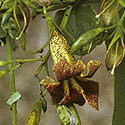 |
|
Podranea
Two species, native to Africa: Podranea ricasoliana
is found at Port St Johns in the Eastern Cape and Podranea brycei
is found in Zimbabwe, Malawi and Mozambique. |
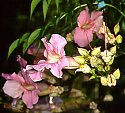 |
|
Rhigozum A
total of seven species, native to Africa and Madagascar, with five species
native to southern
Africa. |
|
|
Spathodea
One species native to southern Africa:
Spathodea
campanulata (African flame tree, Uganda flame tree). |
 |
|
Stereospermum
The fifteen species are distributed in the Old World
tropics, with one species native to southern Africa and another two species
cultivated. |
|
|
Tecoma (Cape
Honeysuckle genus)
[=Tecomaria]
There are about 13 species, of which 12 occur
in the neotropics. The remaining one, Tecoma capensis (Cape
Honeysuckle) is found in southern Africa, from Limpopo down to the Eastern
Cape. It is also widely grown as a garden plant. An additional species is
naturalised in southern Africa, and another five species are
cultivated in the region. |
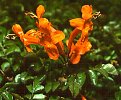 |
Genera naturalised in southern Africa
List from
Plants
of Southern Africa - an Online Checklist (SANBI).
|
Dolichandra
One species is naturalised in southern Africa, and another
species is cultivated. |
|
|
Jacaranda
The 49 species are native to the neotropics.
Jacaranda mimosifolia, is grown
as a garden and street tree in southern Africa. However, it has become
naturalised in woodland regions of South Africa and has now been declared an
ornamental invader plant, meaning that it used for ornamental purposes in
demarcated areas. An additional two species are cultivated in southern
Africa, but not naturalised. |
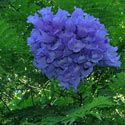 |
|
Macfadyena
The three or four species are native to tropical America.
Macfadyena unguis-cati (Cat's claw creeper) is native from Mexico to Argentina and has been
introduced to South Africa as a garden plant. However, it has become
naturalised in Limpopo, Mpumalanga and KwaZulu-Natal and is a
declared Category 1 invasive plant
in South Africa. |
|
Other genera, cultivated in southern Africa
There are many exotic species from tropical regions that
have been imported for cultivation in gardens in southern Africa, because of
their large, colourful flowers and growth form (mainly creepers and large
trees).
List from Glen (2002). The species name is provided in
genera that have only one species cultivated in southern Africa.
|
Adenocalymma inundatum
Indigenous from Guyana to Peru. |
|
|
Anemopaegma chamberlaynii
Native to Brazil. |
|
|
Arrabidaea selloi (Cipó camarão de sello)
Indigenous from Brazil to Argentina. |
|
|
Bignonia capreolata
|
|
|
Campsis
Two species cultivated. |
|
|
Catalpa
Three species cultivated. |
|
|
Chilopsis linearis (Flowering willow)
Native to southwestern USA, and Mexico. |
|
|
Clytostoma
Two species cultivated. |
|
|
Crescentia cujete (Tree calabash)
Indigenous from Mexico to Panama. |
|
|
Cuspidaria
Two species cultivated. |
|
|
Cybistax antisyphilitica (Ipe verde)
Indigenous from Surinam to Argentina. |
|
Distictis There
are nine species in this genus of climbing, evergreen perenials, native to
Mexico, Central America and the West Indies. Of these, two are cultivated
in gardens in southern Africa:
Distictis buccinatoria (Bignonia cherere), pictured on the right,
and Distictis laxiflora. |
 |
|
Incarvillea delavayi
Native to China. |
|
|
Ophiocolea floribunda
Native to Madagascar. |
|
|
Pandorea
Two species cultivated. |
|
|
Parmentiera cereifera (Candle tree, Chote)
Native to Panama. |
|
|
Phyllarthron madagascariense
Native to Madagascar. |
|
|
Pithecoctenium
Two species cultivated. |
|
|
Pyrostegia venusta (Flame vine, Golden shower)
Native to Brazil and Paraguay. |
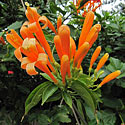 |
|
Radermachera
Two species cultivated. |
|
|
Saritaea magnifica
Native to Colombia and Ecuador. |
|
|
Tabebuia
Fourteen species cultivated. |
|
|
Tecomanthe dendrophila
Indigenous from Indonesia to the Solomon Islands. |
|
|
Tecomella undulata
Indigenous from Arabia to Pakistan. |
|
|
Tourrettia lappacea (Güisquilillo)
Indigenous from Mexico to Argentina. |
|
Publications
-
Diniz, M.A. 1988. Bignoniaceae. Flora
zambesiaca 124.
-
Diniz, M.A. 1990. Bignoniaceae. Flora de
Moçambique 120: 1–35.
-
Diniz, M.A. 1993. Bignoniaceae. Conspectus
Florae Angolensis 122: 1–31.
-
Goldblatt, P. & Gentry, A.H. 1979. Cytology of
Bignoniaceae. Botaniska Notiser 132: 475–482.
-
Glen, H.F. 2002. Cultivated Plants of
Southern Africa. Jacana, Johannesburg.
-
Smithies, S.J. 2000. Bignoniaceae. In: Seed Plants of
Southern Africa (ed. O.A. Leistner). Strelitzia 10: 175-178.
National Botanical Institute, Pretoria.
|
